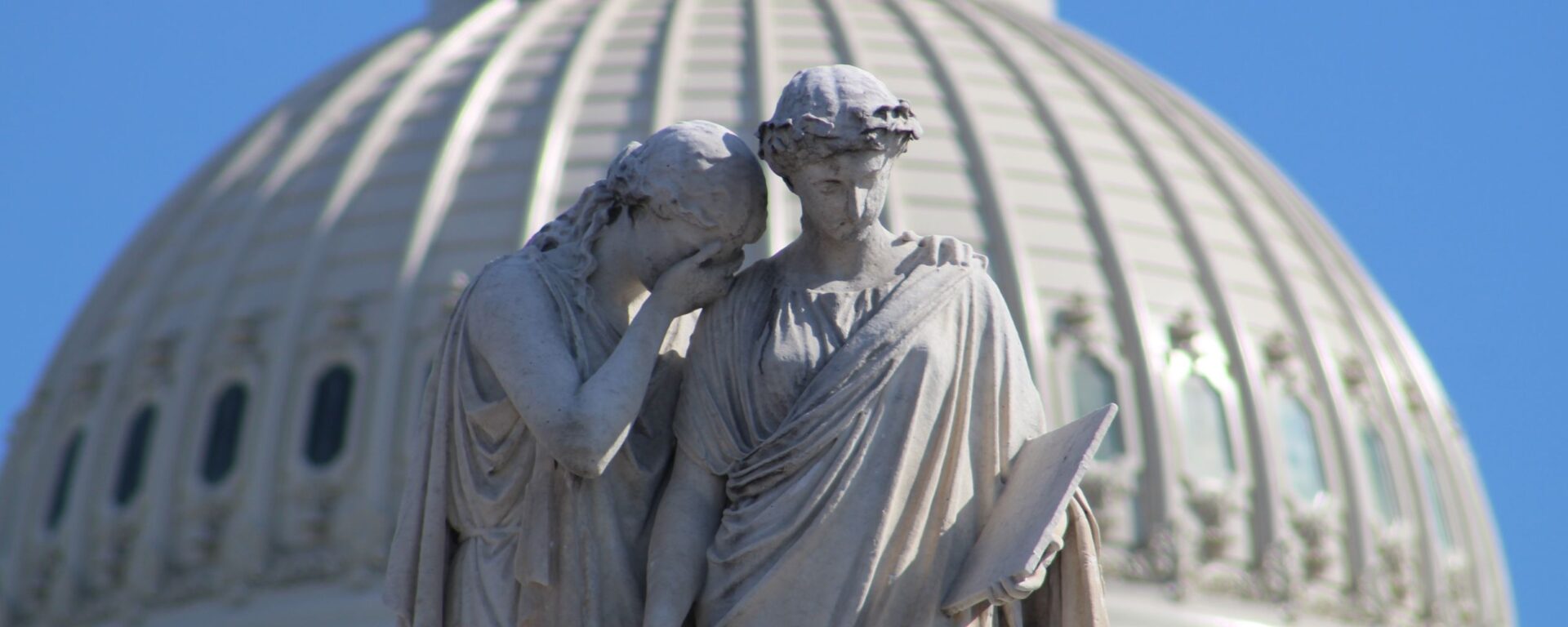“A good Navy is not a provocation to war. It is the surest guaranty of peace.”
Standing in a lonely traffic circle west of the U.S. Capitol building is a memorial that has come to be called the Peace Monument. Most of the visitors it receives have come to see the Ulysses S. Grant Memorial, and few know that it stands in honor of the naval war dead of the American Civil War.

The monument is often criticized for being overwrought with symbolism and unoriginal in execution. It consists of six allegorical figures representing different aspects of the Civil War from a naval perspective. On top of the 40-foot sculpture, facing west, stand two figures representing America and History. History holds a book of the naval war dead inscribed with “They died that their country might live.” Weeping on History’s shoulder, overcome with grief, is America. On the western face of the monument is Victory holding a laurel wreath aloft in her right hand. At her feet, Mars and Neptune are sculpted as toddlers. Mars wears a helmet and carries a sword, Neptune holds a trident. On the eastern face of the monument is Peace, which holds an olive branch. At her feet are symbols of science, art, and industry, implying that these would not be possible in the absence of peace.
The monument was conceived by Admiral David Porter, whose father adopted Admiral David Farragut. Porter rightly feared that after the Civil War, many would forget about the contributions of the navy and focus instead on the victories of the army. To prevent this, Porter sketched out an idea for the statue and raised funds for its creation. He asked sculptor Franklin Simmons to bring his idea to life. Simmons would go on to have a noted career, contributing many works of art to Washington, D.C., including the bronze equestrian of General John Logan that stands in Logan Circle.
It is no understatement that the Civil War changed the nature of naval warfare forever. The United States Navy changed drastically in a very short amount of time. The Union Navy started the war with around 8,000 personnel and, over the course of the war, more than 80,000 would come to serve (10,000 of them black).

Besides growing exponentially, there was a change in the way we thought about naval warfare. Before the war, there was little emphasis on fleet (multiple ship) maneuvers. That outlook changed after the first major naval battle of the war at Port Royal, South Carolina in which the Union employed more than 70 vessels under the command of Rear Admiral Samuel Du Pont. There was also an emphasis on steam powered vessels in contrast to the wind powered vessels that came before. The new steam war ships would prove vital in the Mississippi River campaign since the boats would have to go against the current of the river.

The Civil War also produced many firsts in naval combat. John Ericsson designed the USS Monitor, an ironclad vessel with a rotating turret that fought in the first battle between two iron warships. The Confederates made major innovations in the war as well. The H.L. Hunley was the first submarine to sink an enemy ship in combat: the USS Housatonic. During the war, E.C. Singer (nephew to sewing machine inventor Isaac Singer) invented the spar torpedo (a bomb on a stick) that the Hunley used to sink the Housatonic.

Despite the fact that the naval actions of the Civil War have largely faded from the public memory, their contributions to the war were unquestionable. It was the navy that steamed up the Mississippi to cut the Confederacy in half. It was the Union naval blockade that prevented the South from trading their goods and prevented other countries from intervening on their behalf. It is not an exaggeration to say that the Civil War would not have been won without the intervention and modernization of the Navy.

Resources used for this article:
https://en.wikipedia.org/wiki/Peace_Monument
https://www.aoc.gov/capitol-grounds/peace-monument
https://en.wikipedia.org/wiki/Franklin_Simmons
https://en.wikipedia.org/wiki/American_Civil_War#Naval_war
https://en.wikipedia.org/wiki/Union_Navy
https://en.wikipedia.org/wiki/Confederate_States_Navy
http://www.civilwar.org/education/history/navy-hub/navy-history/pivotal-naval-actions.html
https://en.wikipedia.org/wiki/List_of_Naval_battles_of_the_American_Civil_War
